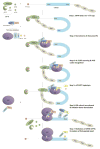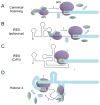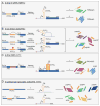RAN translation-What makes it run?
- PMID: 27060770
- PMCID: PMC5003667
- DOI: 10.1016/j.brainres.2016.04.003
RAN translation-What makes it run?
Abstract
Nucleotide-repeat expansions underlie a heterogeneous group of neurodegenerative and neuromuscular disorders for which there are currently no effective therapies. Recently, it was discovered that such repetitive RNA motifs can support translation initiation in the absence of an AUG start codon across a wide variety of sequence contexts, and that the products of these atypical translation initiation events contribute to neuronal toxicity. This review examines what we currently know and do not know about repeat associated non-AUG (RAN) translation in the context of established canonical and non-canonical mechanisms of translation initiation. We highlight recent findings related to RAN translation in three repeat expansion disorders: CGG repeats in fragile X-associated tremor ataxia syndrome (FXTAS), GGGGCC repeats in C9orf72 associated amyotrophic lateral sclerosis (ALS) and frontotemporal dementia (FTD) and CAG repeats in Huntington disease. These studies suggest that mechanistic differences may exist for RAN translation dependent on repeat type, repeat reading frame, and the surrounding sequence context, but that for at least some repeats, RAN translation retains a dependence on some of the canonical translational initiation machinery. This article is part of a Special Issue entitled SI:RNA Metabolism in Disease.
Keywords: Amyotrophic lateral sclerosis; C9orf72; Fragile X-associated tremor ataxia syndrome; Frontotemporal dementia; Huntington disease; Translation initiation.
Published by Elsevier B.V.
Figures



Similar articles
-
High-throughput screening yields several small-molecule inhibitors of repeat-associated non-AUG translation.J Biol Chem. 2019 Dec 6;294(49):18624-18638. doi: 10.1074/jbc.RA119.009951. Epub 2019 Oct 23. J Biol Chem. 2019. PMID: 31649034 Free PMC article.
-
Repeat RNA expansion disorders of the nervous system: post-transcriptional mechanisms and therapeutic strategies.Crit Rev Biochem Mol Biol. 2021 Feb;56(1):31-53. doi: 10.1080/10409238.2020.1841726. Epub 2020 Nov 10. Crit Rev Biochem Mol Biol. 2021. PMID: 33172304 Free PMC article. Review.
-
Repeat-associated non-AUG translation and its impact in neurodegenerative disease.Neurotherapeutics. 2014 Oct;11(4):721-31. doi: 10.1007/s13311-014-0292-z. Neurotherapeutics. 2014. PMID: 25005000 Free PMC article. Review.
-
Ribosomal quality control factors inhibit repeat-associated non-AUG translation from GC-rich repeats.Nucleic Acids Res. 2024 Jun 10;52(10):5928-5949. doi: 10.1093/nar/gkae137. Nucleic Acids Res. 2024. PMID: 38412259 Free PMC article.
-
RNA toxicity in non-coding repeat expansion disorders.EMBO J. 2020 Jan 2;39(1):e101112. doi: 10.15252/embj.2018101112. Epub 2019 Nov 13. EMBO J. 2020. PMID: 31721251 Free PMC article. Review.
Cited by
-
Ubiquitin-interacting motifs of ataxin-3 regulate its polyglutamine toxicity through Hsc70-4-dependent aggregation.Elife. 2020 Sep 21;9:e60742. doi: 10.7554/eLife.60742. Elife. 2020. PMID: 32955441 Free PMC article.
-
[Fragile X associated tremor/ataxia syndrome: its clinical presentation, pathology, and treatment].Rev Neurol. 2019 Mar 1;68(5):199-206. doi: 10.33588/rn.6805.2018457. Rev Neurol. 2019. PMID: 30805918 Free PMC article. Review.
-
Repeat expansion diseases.Handb Clin Neurol. 2018;147:105-123. doi: 10.1016/B978-0-444-63233-3.00009-9. Handb Clin Neurol. 2018. PMID: 29325606 Free PMC article. Review.
-
Structural Features of Small Molecules Targeting the RNA Repeat Expansion That Causes Genetically Defined ALS/FTD.ACS Chem Biol. 2020 Dec 18;15(12):3112-3123. doi: 10.1021/acschembio.0c00049. Epub 2020 Nov 16. ACS Chem Biol. 2020. PMID: 33196168 Free PMC article.
-
Advances on the Mechanisms and Therapeutic Strategies in Non-coding CGG Repeat Expansion Diseases.Mol Neurobiol. 2024 Dec;61(12):10722-10735. doi: 10.1007/s12035-024-04239-9. Epub 2024 May 23. Mol Neurobiol. 2024. PMID: 38780719 Review.
References
-
- Al-Sarraj S, King A, Troakes C, Smith B, Maekawa S, Bodi I, et al. p62 positive, TDP-43 negative, neuronal cytoplasmic and intranuclear inclusions in the cerebellum and hippocampus define the pathology of C9orf72-linked FTLD and MND/ALS. Acta Neuropathol. 2011;122(6):691–702. - PubMed
Publication types
MeSH terms
Substances
Supplementary concepts
Grants and funding
LinkOut - more resources
Full Text Sources
Other Literature Sources
Medical
Miscellaneous

